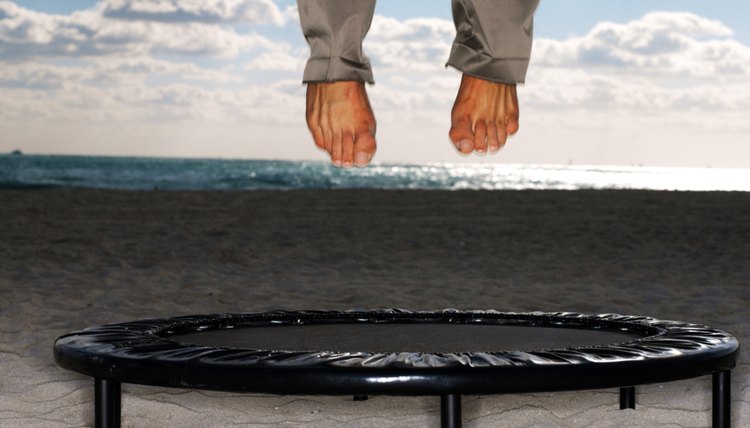Trampoline Alternatives

Trampolines are no longer simply child's play. Once relegated to the backyard, trampolines have made the transition into the fitness world as valid exercise accessories. Trampoline exercise is based on the concept of rebounding, or – simply put – exercise through bouncing. When practiced regularly, the potential health benefits of rebounding include increased leg and core strength, improved balance and coordination and a stronger immune system. For fitness rebounding purposes, you have plenty more options to choose from than traditional trampolines.
Rebounding Basics
At its core, bouncing during exercise increases the gravitational force on your body, and your body responds to this increased resistance -- resistance that is often two to three times your bodyweight -- by strengthening. The constant change of gravity during rebounding leads to repeated tensing and relaxing of the muscles, which encourages drainage of the lymphatic system and helps reduce stress. Heart rate-elevating rebounding serves as aerobic exercise -- which improves cardiovascular health -- and helps tone and firm the lower body.
Mini Trampoline
Also known as rebounders, mini trampolines are the most viable alternative to full-sized trampolines for rebounding exercise. While traditional trampolines are made for recreation, rebounders cater specifically to fitness with higher quality mats and shorter, harder springs. These exercise accessories are also cheaper and more portable than their full-sized brethren. Mini trampolines accommodate exercises such as jumping, jogging and heel lifts.
Exercise Ball
Versatile stability balls lend themselves to everything from crunches to pushups, and rebounding is no exception. Exercise balls accommodate low-impact rebounding exercises, allowing you to bounce lightly during your workout. Rebounding exercises for stability balls include seated ball jogging and bounce lifts. While these accessories may not provide the calorie burn of mini trampolines, they offer a lower price tag and greater versatility.
Rebounding Shoes
Rebounding lessens the impact of exercises such as jogging and jumping on the joints; rebounding shoes take this concept to a whole new level by actually strapping rebounders to your feet. These spring-equipped boots allow you to jump, run and even dance both indoors and out, adding the benefits of bouncing to traditional cardio exercises. As is the case with mini trampolines, some gyms offer fitness classes that cater specifically to rebounding shoes. Of all the trampoline alternatives, however, rebounding shoes come with the heftiest price tag.
References
- Gaiam Life: Trampoline Fitness: Can You Bounce Your Way to Better Health?
- Bellicon: Health Benefits
- Mail Online: Tone and Tighten with a Rebounding Six Week Workout
- Fitness Magazine: Insider's Guide to Stability Balls
- Shape: Stability Ball Bounce Lift
- Spine Health: Exercise Ball Uses
- Duke Sports Medicine Center: Mike Huff Featured in the Raleigh News and Observer – Spring Training
Resources
Writer Bio
Dan Ketchum has been a professional writer since 2003, with work appearing online and offline in Word Riot, Bazooka Magazine, Anemone Sidecar, Trails and more. Dan's diverse professional background spans from costume design and screenwriting to mixology, manual labor and video game industry publicity.
